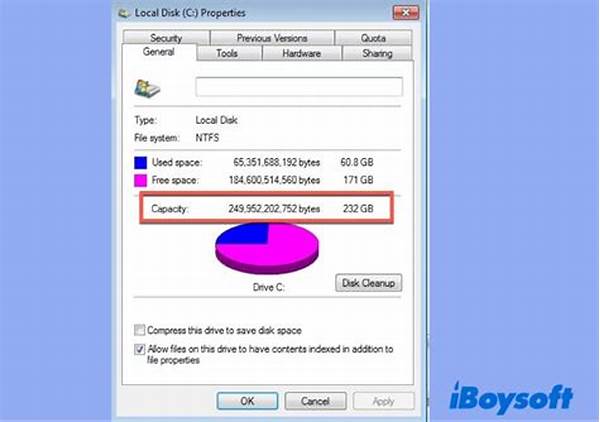In today’s digital age, managing your computer’s storage capacity efficiently is crucial. As you accumulate files and applications over time, it is common to encounter disk space constraints, especially on devices running Windows. Whether you’re looking to improve performance or simply need room for new files, learning how to optimize your storage can be a game changer. In this article, we delve into effective strategies to free up Windows disk space, ensuring your system runs smoothly and efficiently.
Read Now : Step-by-step Desktop Dust Removal
Understanding the Importance of Freeing Up Disk Space
Proper management of your computer’s storage not only enhances operating speed but also extends the lifespan of your hard drive. As disk space fills up, systems tend to slow down, and tasks that once took seconds may now drag on interminably. Hence, learning how to free up Windows disk space becomes essential for maintaining peak performance. Regularly clearing out unnecessary files and programs helps in optimizing processes and ensures that essential applications have the space they need to function properly. Naturally, a decluttered drive also offers more room for important work files, multimedia, and any new software applications.
Space constraints can also affect system updates, which are critical for security and feature enhancements. Without sufficient space, these updates may fail, leaving your system vulnerable to potential threats. Moreover, freeing up disk space aids in minimizing boot time and ensures quicker access to the files you actually need. By maintaining an organized and less congested disk, you’re investing in the longevity and efficiency of your system. Therefore, recognizing the cues that it might be time to declutter and taking proactive steps to do so can significantly improve your daily computing experience.
Additionally, modern computers often come with limited storage capacities due to the prevalence of solid-state drives (SSDs), which, while fast, usually offer less storage space than traditional hard drives. Hence, the ability to quickly and effectively free up Windows disk space is an essential skill for maximizing your device’s potential. As a user, being aware of what takes up storage and how to manage it efficiently enables you to use your system to its full extent.
Effective Methods to Free Up Windows Disk Space
1. Disk Cleanup Tool: Utilizing Windows’ built-in Disk Cleanup tool can effectively help free up disk space by removing temporary files, downloaded program files, and system cache that are no longer necessary.
2. Uninstall Unused Programs: Regularly review and uninstall applications that are seldom used. This not only helps to free up Windows disk space but also improves operating speed by reducing background processes.
3. Move Files to Cloud Storage: Transfer infrequently accessed files to cloud storage services like OneDrive or Google Drive. This action not only frees up disk space but also offers added security through backup.
4. Delete Duplicate Files: Use specialized software to locate and remove duplicate files. Reducing redundancy can significantly contribute to freeing up disk space on your Windows PC.
5. Manage Large Files: Identify and delete or move large files that are no longer needed. A thorough review of seldom-used media files and documents can recover substantial space.
Advanced Techniques for Disk Space Optimization
Disk space optimization is pivotal when your system’s performance is at stake. One advanced method to free up Windows disk space is by enabling storage sense on your device. Storage sense automatically deletes junk files and manages cloud storage content effectively. By configuring this feature appropriately, you can ensure consistent optimization of your disk space without constant manual intervention.
Moreover, when traditional methods aren’t sufficient, consider partitioning your hard drive. Partitioning helps in organizing data better and can even make system backups more straightforward by allowing you to manage specific disk areas differently. Another advanced method involves using command-line tools like “PowerShell” to clear temporary data and redundant files. While these methods may seem complex initially, they reap long-term benefits in terms of system performance and space management.
Lastly, proper management of system restore points can also free up Windows disk space significantly. Deleting older restore points that are no longer needed helps conserve space while ensuring you have the necessary backups. At the end of the day, implementing such advanced techniques means you’re taking a proactive role in maintaining an efficient computing environment, ultimately ensuring your system operates at its full potential over its lifespan.
Tools for Managing Disk Space
1. CCleaner: A renowned tool that helps users analyze and free up Windows disk space by cleaning up redundant files and invalid registry entries without much effort.
2. TreeSize Free: This tool offers a detailed view of file and folder sizes. It helps identify space hogs for removal, effectively assisting in freeing up disk space.
3. WinDirStat: A visual disk usage statistics viewer, WinDirStat allows users to visualize their data usage, making it easier to decide what to delete and free up Windows disk space.
4. Duplicate Cleaner: Identify and delete duplicate files stored on your system with ease to free up significant disk space using this intuitive tool.
Read Now : Optimizing Bios For Performance
5. SpaceSniffer: With its user-friendly graphical interface, SpaceSniffer helps spot large files and folders, assisting in efficient disk space management.
6. Storage Sense: A Windows feature that automatically manages disk space cleanup, deleting temporary files and managing content, aiding in continuous freeing up of disk space.
7. Auslogics Duplicate File Finder: This dedicated file finder helps in locating and removing duplicate files quickly, helping free up Windows disk space.
8. System Mechanic: An all-in-one performance tool that features disk cleanup among other functions, contributing to system optimization and space management.
9. O&O DiskStat: Helps users find large files and folders and provides insights for efficient disk space usage, critical for any disk space management strategy.
10. Glary Utilities: Offers various features, including disk space cleanup utilities, aiding users in freeing up Windows disk space efficiently.
The Role of Regular Maintenance in Disk Space Management
Regular maintenance plays an indispensable role in managing and freeing up Windows disk space. Implementing a routine schedule for disk cleanups and system audits can prevent the accumulation of unnecessary data. It is vital to proactively manage your storage rather than waiting until your disk is nearly full to take action. Integrating regular assessments into your routine means identifying storage heavyweights and removing temporary files before performance issues arise.
Incorporating software updates and removing outdated programs are also critical steps in a disk maintenance regime. Outdated software not only consumes disk space but may also introduce security vulnerabilities. Consistent updates can free up disk space by replacing older, larger file versions with more optimized ones, ensuring your device operates smoothly and securely. Moreover, maintaining a clear update schedule ensures seamless performance enhancements without unexpected interruptions.
Ultimately, the role of regular maintenance extends beyond merely freeing up Windows disk space. It’s about creating a sustainable computing environment that supports your usage patterns efficiently. By investing time in consistent cleanup activities and advancements, you foster a responsive and agile computing experience, laying the groundwork for an organized digital life that complements your productivity goals.
Conclusion: Achieving Balanced Disk Space Utilization
Achieving balanced disk space utilization may seem daunting, but with the right tools and techniques, it becomes attainable. The journey to free up Windows disk space starts with identifying key areas of potential waste and applying both common and advanced methods of storage management. Ultimately, it is about striking a balance between necessary space-saving techniques and maintaining access to essential files and programs.
With the plethora of tools available, users have many opportunities to tailor their disk space management strategies to their personal needs. From leveraging default Windows features to exploring third-party applications, the scope for effective disk space optimization is vast. Self-educating on these tools and methodologies ensures a sustainable approach is employed, maximizing the benefits in both the short and long term.
Though the process of freeing up disk space requires dedication, its impact on system performance and reliability is indisputably positive. Regularly reviewing and adjusting storage strategies minimizes the need for urgent action and promotes an efficient computing environment. By embracing these strategies, users protect their systems against the disruptions that come from inadequate storage planning, ensuring that storage space is a valuable asset rather than a constant hurdle.





